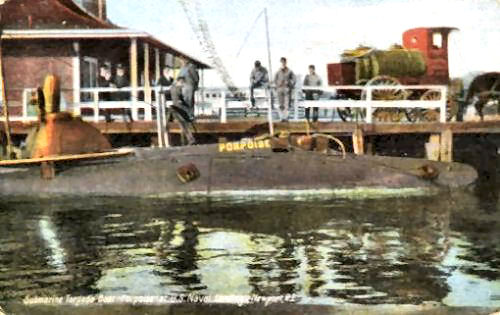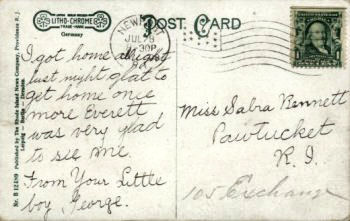![]()
Postal History Introduction
Stampless
Covers
1846
to 1900 Issues
1901-1950
Issues
1951-2003
Issues
Cancels
&
Miscellaneous
Postal
Stationery
Post
Cards
Air
Mail
First
Day &
Event Covers
Parcel Post/Special Delivery
Registered & Official Mail
Commercial & Advertising
Revenue & Postage Due
Wildlife & Game Issues
Complete List of RI Issues
|
Rhode Island Picture
Post Cards |
|
|
|
|
|
|
The post card was mailed to a Miss Sabra Bennett in Pawtucket, RI from her son George on July 28, 1908 and the message reads: I got home all right last night. glat (glad) to get home once more. Everett was very glad to see me - From Your Little boy George. Although this postcard was dated and sent in July of 1908; The Porpoise was in Newport, RI only during the years 1903 and 1904. In 1908 Porpoise was headed for the Pacific and the Philippine Islands. There is an interesting horse drawn tanker wagon depicted at the upper right of the post card. The tank could have been for supplying fresh water or for removing waste/pumping out sanitary tanks. HISTORY OF THE USS PORPOISE
The Submarine Torpedo Boat was initially assigned to Naval Torpedo Station - Newport, Rhode Island for experimental torpedo firing work. Porpoise entered the New York Navy Yard in September 1904 for repairs and alterations, remaining there until February 1906. On March 7, 1907, Porpoise was assigned to the First Torpedo Flotilla and operated from Annapolis, Maryland providing training and instruction naval cadets, until June 1907. Porpoise was taken to the New York Navy Yard and decommissioned on April 21, 1908. She was then partially disassembled and loaded onto the after well deck of the collier Caesar for a voyage to the Philippine Islands as deck cargo along with her sister ship Shark, (Submarine Torpedo Boat No. 8) via the Suez Canal. Arriving at the Naval Station at Cavite, Porpoise was reassembled, launched on July 8, 1908 and recommissioned on November 20. Because of the small size of the Porpoise Class Boats, officers and men lived on board the gunboat USS Elcano. In April 1909, Ensign. Kenneth Whiting, a future naval aviation pioneer became Porpoise's commanding officer. On April 15 Whiting and his crew of six took the submarine out for what was to be a routine run. Porpoise got underway, cleared the dock and moved out into Manila Bay. She dove soon thereafter and leveled off at a depth of 20 feet. Only then did Ensign Whiting reveal his intentions to the crew. Convinced that a man could escape from a submarine through the torpedo tube, Whiting determined that he was going to try and test his theory with himself as a guinea pig. Squeezing into the 18-inch diameter tube, he clung to the crossbar which stiffened the outer torpedo tube door, as the crew closed the inner door. When the outer door was opened and water rushed in Whiting hung onto the crossbar that drew his elbows out of the tube's mouth, and then muscled his way out using his hands and arms, the entire evolution consuming 77 seconds. He then swam to the surface, Porpoise surfacing soon thereafter. Ensign Whiting then informed his flotilla commander, Lieutenant Guy W. S. Castle, who submitted a report on how the feat had been accomplished. In Porpoise's log that day, Whiting had simply commented: "Whiting went through the torpedo tube, boat lying in (the) water in (a) normal condition, as an experiment ...." On December 9, 1909, Porpoise became a unit of the First Submarine Division, Asiatic Torpedo Fleet and commenced a routine of local operations out of Cavite during the following ten years. Renamed A-6 (Submarine Torpedo Boat No. 7) on November 17, 1911; she patrolled the entrance to Manila Bay and convoyed vessels out of port during World War I under the command of Lieutenant A. H. Bailey. Submarine A6 was decommissioned on December 12, 1919 and turned over to the Commandant of the Naval Station at Cavite, for disposal. Given the alphanumeric hull number SS-7 on July 17, 1920; Submarine A-6 was authorized for use as a target in July 1921 and removed from the Naval Register January 16, 1922. Sources: |
![]()
RI Historical Society
The Post Offices
Home Page
RI Tercentenary Issue History
RI Philatelic Society
Recently Added Pages
Philatelic Primer
Rhode Island Around the World
Rhode Island
Town Postmarks
Other Websites of Interest

